
Bulletin 6 (III:2), 1965
Home
Français
Introduction
History
Annual Index
Author &
Subject
Credits
Contact
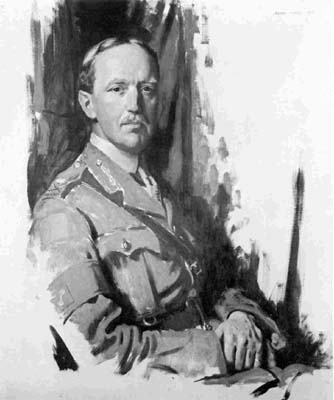
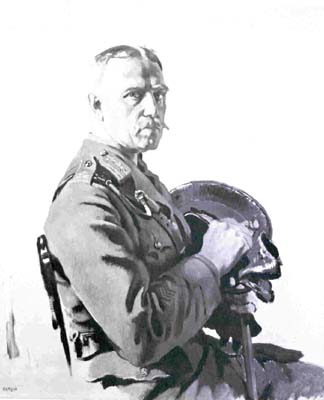
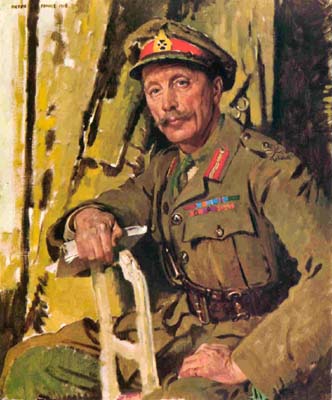
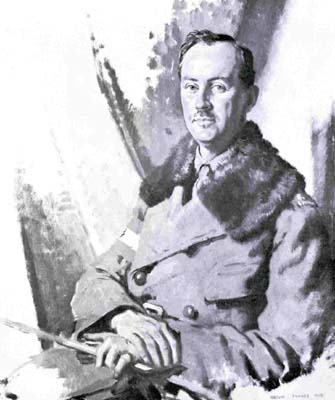
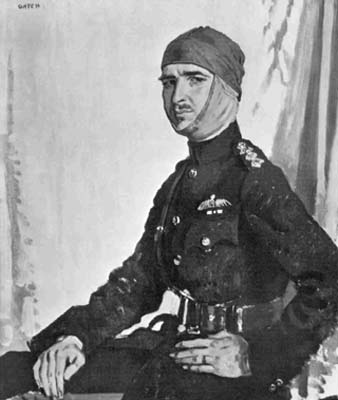
Orpen
Portraits in the Canadian
War Memorials Collection
by Robert F. Wodehouse,
Curator of War Art
Pages 1 | 2 |
3 | 4
Louis James Lipsett (1874-1918) was born at Bundoran, Ireland, 14
June 1874 of a family of Welsh origin. He was educated at Bedford
School and Sandhurst and commissioned 2nd Lieutenant Royal Irish
Regiment (18th Foot) on 10
October 1894. He served in the Tirah Campaign, North West Frontier
of India, and later in South Africa and in a variety of Staff appointments. Appointed General Staff
Officer for Western Canada with the local rank of major in 1911
under the policy of standardizing training between Great Britain and
the Dominions agreed to at the Imperial Conferences of 1907 and
1909. He served under Lieutenant-General Sir Archibald Macdonell
during
this period and instructed, among others, Sir Arthur Currie (then
Lieutenant-Colonel Commanding 50th Gordon Highlanders in
Victoria) and Major-General Garnet Hughes (then 2nd in command of
the 50th Gordons). On outbreak of war was offered and accepted
command of the 90th Winnipeg Rifles (the Little Black Devils), 8th
Battalion, Canadian Expeditionary Force. He succeeded Brigadier-General A. W. Currie in command 2nd Canadian Infantry Brigade when
latter was appointed to command 1st Canadian Division, and succeeded Major-General Mercer, when latter was killed
at Mount Sorrel, in command of 3rd Canadian Division in June 1916.
Transferred back to the British Regular Army as GOC 4th Division in
1918. Killed at Haspres, France, 14 October 1918. Buried with full
honours for his rank at
Quéant in France by members of the 3rd Canadian Division in the
presence of H. R. H. the Prince of Wales, General Horne, commander
First Army, and Sir Arthur Currie, Canadian Corps Commander. He was
awarded a CB, a CMG, and the French
Légion d'Honneur and Croix de Guerre avec étoile en
argent et avec palme for his services.
Sir Frederick Oscar Warren Loomis (1870-1937) was born at
Sherbrooke, Quebec, 1 February 1870. He was educated at the University of Bishop's
College, and became a general contractor. He enlisted in the Canadian Militia as a
private in 1886; in 1914 he was given command of the 13th Battalion,
Canadian Expeditionary Force. He was promoted brigadier-general in
1916, and in 1918 major-general, commanding the 3rd Canadian
Division. He was awarded the DSO in 1915 (bar in 1918), as well as several foreign decorations;
he was created a CMG 28 in 1917, and a KCB in 1919. He retired to civilian life
in 1919, and he died in Montreal on 15 February 1937.
Sir David Watson (1871-1922) was born
at Quebec, 7 December 1871, the son of William Watson and Jean
Grant. He was educated in the public schools of Quebec, and became a
journalist. In 1901 he became managing director of the Quebec Chronicle.
In 1900 he was gazetted a lieutenant in the 8th Royal Rifles of
Quebec, and in 1911 he became its commanding officer, with the rank
of lieutenant-colonel. On the outbreak of war he was given command
of the 2nd Battalion of the Canadian Expeditionary Force. In 1915
he was promoted to be brigadier-general in command of the 5th
Brigade and in 1916 he was given command of the 4th Canadian
Division, with the rank of major-general. At the end of the war he
was the senior divisional commander of the Canadian Corps. He died
in Quebec on 19 February 1922. In 1918 he was created, in recognition of his war
services, a KCB.
Henry Willis-O'Connor (1886-1957), born 1 April 1886 at Ottawa. Served with the Governor General's Foot
Guards, Ottawa, from 1911 to 1914. Joined 2nd Battalion, Canadian
Expeditionary Force, 22 September 1914 as Captain and Adjutant and
proceeded to France with the unit in February 1915. He was twice
wounded in May and June of 1915 after which he was appointed ADC to GOC 1st Division in September 1915. Promoted temporary major
Apri1 1916. Appointed ADC to GOC Canadian Corps June 1916. Returned
to Canada 1919. Appointed ADC to the Governor General (Lord Byng) in
1921. Retired from the Army in 1946 with the rank of colonel. He
died in Ottawa, 25 April 1957 .He was awarded the DSO and was twice
mentioned in despatches in World War I.
Reginald Theodore Carlos Hoidge (1894-1963) was born in Toronto, the son of John Robert
Hoidge. He enlisted in the Officers Training Corps of the University of Toronto in October 1914,
receiving his commission as 2nd lieutenant in the Royal Garrison Artillery in June 1916. He transferred to the
Royal Flying Corps two months later. He joined No.56 Squadron in
January 1917 and accompanied it to France in April of that year. There he flew in
company with such outstanding fliers as Captain Albert Ball, VC,
Major J. T. B. McCudden, VC, Major G. T. C. Maxwell, and Lieutenant
A. P. F. Rhys Davids. All in all, he is credited with destroying or
sending down out of control a total of 25 enemy aircraft. In
September 1917 he took part with Rhys Davids in the combat in which
Fliegerleutenant Werner Voss was killed.
Voss was at the time the second-highest-scoring German pilot, with
49 credited victories.
After completing 83 patrols with No.56 Squadron, Hoidge was
posted back to Britain in November 1918 and joined the
staff of the Central Flying School. Shortly afterwards he was
injured in an accident and returned to France only in September
1918, where he joined No.1 Squadron. He returned to Canada in May
1919.
He was one of the early outstanding Canadians with the RFC,
being promoted lieutenant (honorary captain) in the RAF in April
1918. He is listed in the memoirs of Lord Douglas of Kirtleside as one of a group of pilots under his
command who were capable of successfully combatting the Flying Circus of Von Richthofen at a crucial moment in the war. He
was awarded the Military Cross in July 1917 and a Bar in October of
the same year. He settled in New York City, where he died in 1963.
Next Page | Notes
1 | 2 |
3 | 4
Annual Index | Author & Subject | Credits | Contact
This digital collection
was produced under contract to Canada's Digital Collections program,
Industry Canada.
"Digital
Collections Program, Copyright
© National Gallery of
Canada 2001"